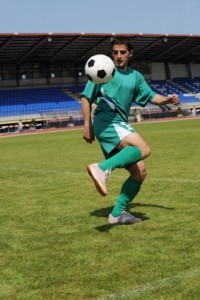Goalkeepers are often taken by surprise by a first-time shot. When an attacking player stops the ball, it not only gives a  defending player a chance to close him down but it also gives the keeper a chance to prepare himself for the shot. Many goal scoring opportunities have been lost because of a player’s hesitance to shoot first-time. A large proportion of first-time shooting will involve striking the ball when it’s off the ground.
defending player a chance to close him down but it also gives the keeper a chance to prepare himself for the shot. Many goal scoring opportunities have been lost because of a player’s hesitance to shoot first-time. A large proportion of first-time shooting will involve striking the ball when it’s off the ground.
Many young players, especially pee wee age, kindergarten, or under 10’s don’t like to attempt things that might make them look silly or won’t be successful. Volleying for shots is a skill that even older players don’t spend time developing because they believe it to be a low “return on investment” when in a scoring opportunity. This is a skill you can introduce to your players of any age and if some take a liking to it then you might have more range to your attack.
Here are some soccer drills that you can show your players to get them started…
Drill 1) Begin your practice with a ball on a string. Hold the string so that the ball is about 12 inches from the ground. Make contact with the ball by using the full instep, keeping the ankle firm and the toes pointed down. Practice kicking with different parts of the foot and at different angles.
Drill 2) Most of the volley chances at goal will come from balls being centered from the wings. This means that the ball will approach you on a different course from the one you are going to send it on. This is more difficult and you must concentrate on keeping your eye on the ball and holding your head steady. Pivot on the standing leg as you strike the ball, and make your kicking leg swing on an arc that brings it in a horizontal line on to the ball or even downwards on to it. If you aren’t careful, the ball will almost always fly high and over the bar.
To practice this, allow the ball on the string to swing just a shade higher, about knee high. As you direct the ball downwards, swing your foot almost parallel with the ground and follow through downwards towards the ground. Some players favor contact with the outside of the instep.
Drill 3) Then, lengthen the string and suspend the ball from high overhead. Your body is now free and the use of your arms will naturally help you to balance your movements. Set the ball hanging about 12 to 14 inches from the ground and stand about 18 to 20 inches behind the ball. Make contact that’s not too hard, but hard enough to get a feel for the ball. As the ball swings back to you, kick it again as this will help cultivate the timing of the kick. It’s also a good idea here to try to kick the ball with a short back-swing of the leg because often you will not have time for a long swing. Gradually increase the power of your shot. Keep your toes well down and visualize an actual shot in a game being taken.
Drill 4) On your own, throw the ball about ten feet in the air, allow it to bounce once, and then volley the ball at a target before it bounces a second time. Next, stand side-on to the target and, before the ball bounces a second time, make a firm contact as you pivot on-the non-kicking foot.
Drill 5) A fun game to help improve volleying is volley tennis. The rules are the same as for lawn tennis and can be played on a tennis court with a net. The ball must be volleyed over so that it bounces in the opponents’ court. Your opponent can either volley it back first time or control it with his body so that it does not bounce a second time before he volleys it back.
There are many variations to volleying drills, but whatever you do remember to have your players get into the line of flight and to meet the ball quickly. Aim to hit the ball cleanly, and try to crack the ball down on to the target. Volleying is a skill that requires practice, but the effort will be worthwhile when the ball will be in the back of the net in the time it takes others to control it before they shoot.


No comments yet.